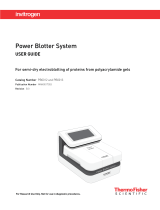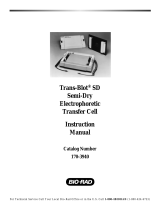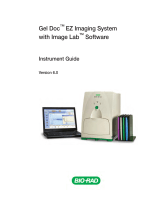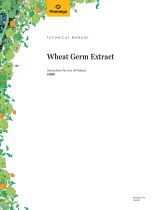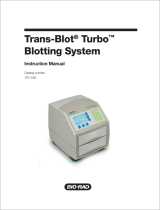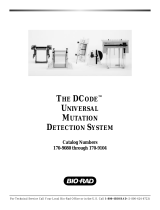Page is loading ...

E-PAGE™ Technical Guide
General information and protocols for using E-PAGE™ Gels
Catalog Number EP096-06
Revision B.0
Publication Number MAN0000374
Publication Part Number 25-0644
For Research Use Only. Not for use in diagnostic procedures.

For support visit www.lifetechnologies.com/support or email [email protected]om
www.lifetechnologies.com
06 October 2021

iii
Contents
Product Contents ........................................................................................................................................ iv
Introduction ................................................................................................................................. 1
E-PAGE™ Protein Electrophoresis System ................................................................................................ 1
E-PAGE™ System Components .................................................................................................................. 3
Methods ....................................................................................................................................... 8
Electrophoresis of E-PAGE™ Gels ......................................................................................... 8
Guidelines for Sample Preparation ............................................................................................................ 8
Electrophoresis of E-PAGE™ Gels ............................................................................................................ 13
Running E-PAGE™ Gels ............................................................................................................................. 17
Guidelines for Loading E-PAGE™ Gels by Automated Liquid Handling .......................................... 18
Using E-Holder™ Platform ........................................................................................................................ 20
Opening the E-PAGE™ Cassette ............................................................................................................... 24
Blotting E-PAGE™ Gels ......................................................................................................... 25
Blotting E-PAGE™ Gels with the iBlot® Device ...................................................................................... 25
Semi-Dry Blotting of E-PAGE™ Gels ........................................................................................................ 31
Semi-Wet Blotting of E-PAGE™ Gels ....................................................................................................... 35
Visualizing and Staining of E-PAGE™ Gels ........................................................................ 38
Visualizing Lumio Fusion Proteins ....................................................................................................... 39
SYPRO® Ruby Staining Protocol .............................................................................................................. 40
Coomassie Staining .................................................................................................................................... 41
SimplyBlue™ SafeStain ............................................................................................................................... 43
Silver Staining Methods ............................................................................................................................. 45
InVision™ His-tag Protein Gel Stain ......................................................................................................... 48
Drying of E-PAGE™ Gels ...................................................................................................... 49
Gel Drying ................................................................................................................................................... 49
Analysis and Troubleshooting ............................................................................................ 51
Molecular Weight Calibration .................................................................................................................. 51
Expected Results ......................................................................................................................................... 53
Using E-Editor™ 2.02 Software .................................................................................................................. 60
Troubleshooting .......................................................................................................................................... 61
Appendix .................................................................................................................................... 63
Additional Staining Protocols ................................................................................................................... 63
Product Specifications ................................................................................................................................ 67
Accessory Products .................................................................................................................................... 70
Technical Support ....................................................................................................................................... 72

iv
Product Contents
Purpose of the
Guide
The E-PAGE™ Technical Guide contains information about E-PAGE™ Gels and
is intended to supplement the manuals supplied with E-PAGE™ Gels. Details
for sample preparation, electrophoresis conditions, blotting, and staining are
included in this guide.
Types of Kits
E-PAGE™ gels are designed for use with the E-Base™ Electrophoresis Device,
and are available in 48-well or 96-well formats. See pages 3–4 for further
specifications. See page 71 for ordering information.
Product Quantity Catalog no.
E-PAGE™ 48 8% Gels 8-pack EP048-08
E-PAGE™ 96 6% Gels 8-pack EP096-06
Kit Contents
Each pack of E-PAGE
™
Gels contain the following contents:
E-PAGE™ Gel 8-Pack Contents Quantity
E-PAGE Gels 8 gels
E-PAGE Loading Buffer 1 (4X) 4.5 mL
E-PAGE Blotting Pad 1
Shipping and
Storage
The E-PAGE™ 48 and 96 Gels, E-PAGE Blotting Pad and Mother E-Base™ are
shipped and stored at room temperature.
Do not allow the temperature to drop below 4°C or rise above 40°C when
storing the gels.
The E-PAGE Loading Buffer is shipped at room temperature. Store the
E-PAGE™ Loading Buffer 1 (4X) at room temperature or at 4°C.

1
Introduction
E-PAGE™ Protein Electrophoresis System
About the
E-PAGE™ Protein
Electrophoresis
System
The E-PAGE™ Protein Electrophoresis System is designed for fast, medium-to-
high-throughput protein electrophoresis in a horizontal format.
The self-contained E-PAGE™ 48 or 96 Pre-cast Gels consist of a buffered gel
matrix and electrodes packaged inside a disposable, UV-transparent cassette.
The gels can be loaded by multichannel pipetter or automated loading system.
Electrophoresis of the samples is performed with the E-Base™ Electrophoresis
Device. The E-Base™ Electrophoresis Device consists of a base for
electrophoresis, and an integral power supply. After electrophoresis is
completed, the cassette can be opened with the Invitrogen™ Gel Knife (Cat.
No. EI9010, sold separately) to perform downstream applications such as
western blotting or staining.
The E-Editor™ 2.02 software allows digital images of the E-PAGE™ Gels to be
reconfigured into a side-by-side format for easy comparison and analysis.
Applications
The E-PAGE™ Protein Electrophoresis System is ideal for screening protein
samples using the following applications:
• In-gel staining with Lumio™ Green Reagent
• Western blotting
• Staining (Coomassie, silver, or fluorescent stains)
• Functional assays
Advantages
Using E-PAGE™ Gels for protein analysis offers the following advantages:
• Produces fast, safe, and consistent electrophoresis
• Eliminates the need to prepare gels and buffers
• Compatible with most commercially available automated liquid handling
systems for high-throughput electrophoresis
• Available in two well formats to suit your applications
• Easy to open gel cassettes facilitate downstream staining and blotting
applications
• Ability to track samples during electrophoresis of multiple gels using an
individual barcode on each gel cassette

2
E-PAGE™ Protein Electrophoresis System, Continued
Choosing a Gel
for your
Application
To obtain the best results for your application it is important to choose the
correct E-PAGE™ Gel. The table below describes the major features of each
format. For specifications and separation range of each gel type, see page 67–68.
E-PAGE™ Gel No. Rows No. Wells Well Volume Run
Length
Run
Time
48 Gel 2* 48 sample
4 marker
15 µL
15 µL 3.2 cm 25 min.
96 Gel 8* 96 sample
8 marker
20 µL
20 µL 1.6 cm 14 min.
*Wells compatible for loading with a multichannel pipetter or with an automated
liquid handling system.
Western Blotting
of E-PAGE™ Gels
E-PAGE
™
Gels are suitable for western blotting. The iBlot
®
Gel Transfer Device
is recommended method for blotting E-PAGE™ Gels (page 25). Semi-dry
blotting (page 25), and semi-wet blotting may also be performed (page 35).
Tank blotting is not recommended, but can be performed if even pressure is
maintained between the gel and the membrane, and cooling is provided.
Staining E-PAGE™
Gels
E-PAGE
™
Gels are compatible with many standard Coomassie, silver, or
fluorescent staining protocols. E-PAGE™ Gels are thicker than most SDS-PAGE
mini-gels, so additional time may be required for staining and destaining steps.
We recommend the following stains for E-PAGE™ Gels. Detailed staining
protocols are described on pages 38–48.
Total Protein Stains:
• SYPRO® Ruby Protein Gel Stain (page 38)
• Coomassie Stain (page 41)
• SimplyBlue™ SafeStain (page 43)
• SilverQuest™ Silver Staining Kit (page 46)
• SilverXpress® Silver Staining Kit (page 47)
Specific Protein Stains:
• Lumio™ Green Detection Reagent for detecting Lumio fusion proteins
(page 38)
• InVision™ His-tag In-Gel Stain for detecting 6X His-tagged proteins
(blotting recommended first, page 48)

3
E-PAGE™ System Components
Introduction
The E-PAGE™ Protein Electrophoresis System consists of the following
components:
• E-PAGE™ 48 or 96 Pre-cast Gels
• E-Base™ Electrophoresis Device
• E-Holder™ Platform
• E-PAGE™ Loading Buffer 1 (4X)
• E-PAGE™ Blotting Pad
• E-Editor™ 2.02 Software
Details on each system component are described in this section.
E-PAGE 48 Gels
•
E-PAGE™ 48 Gels are self-contained, pre-cast gels that include a buffered
gel matrix and electrodes packaged inside a disposable, UV-transparent
cassette.
• Each E-PAGE™ 48 Gel contains 48 sample lanes and 4 marker lanes. This
configuration provides a 3.2-cm run length. The wells of E-PAGE™ 48 Gels
are compatible for loading with a multichannel pipetter in alternating lanes
or with an automated liquid handling system (see page 17 for automation
specifications).
• After electrophoresis, the E-PAGE™ 48 cassette is easily opened with the
Invitrogen™ Gel Knife (Cat. No. EI9010, sold separately) to remove the gel
for staining or blotting applications.
• Each E-PAGE™ 48 cassette is labeled with an individual barcode to facilitate
identification of the gel using commercial barcode readers (page 13).
See page 67 for E-PAGE™ 48 8% Gel specifications.
Diagram of an
E-PAGE
48
Cassette
A diagram of the E-PAGE
™
48 Gel cassette is shown below.
Plastic combs
Copper
electrode (-)
Copper
electrode (+)
Barcode

4
E-PAGE™ System Components, Continued
E-PAGE 96 Gels
• E-PAGE
™
96 Gels are self-contained, pre-cast gels that include a buffered
gel matrix and electrodes packaged inside a disposable, UV-transparent
cassette.
• Each E-PAGE™ 96 Gel contains 96 sample lanes and 8 marker lanes in a
patented staggered well format that provides a 1.6-cm run length. The wells
of the E-PAGE™ 96 gels are compatible for loading with a multichannel
pipetter or with an automated liquid handling system (See page 17 for
automation specifications).
• After electrophoresis, the E-PAGE™ cassette is easily opened with the
Invitrogen™ Gel Knife (Cat. No. EI9010, sold separately) to remove the gel
from the cassette for staining or blotting applications.
• Each E-PAGE™ 96 cassette is labeled with an individual barcode to facilitate
identification of the gel using commercial barcode readers (page 13).
See page 67 for E-PAGE™ 96 6% Gel specifications
Diagram of an
E-PAGE™ 96
Cassette
A diagram of the E-PAGE™ 96 Gel cassette is shown below.
Copper
electrode (+)
Copper
electrode (-)
Barcode
Plastic combs

5
E-PAGE™ System Components, Continued
E-Base
Electrophoresis
Device
E-PAGE™ Gels are used with a specially designed electrophoresis device that
combines a base and a power supply. Two types of devices are available from
Life Technologies:
• The Mother E-Base™ (Cat. no. EB-M03) has an electrical plug that can be
connected directly to an electrical outlet and is used for electrophoresis of
one E-PAGE™ Gel. The Mother E-Base™ has been tested for electrophoresis
with up to three Daughter E-Bases™ connected at one time.
• The Daughter E-Base™ (Cat. no. EB-D03) connects to the Mother E-Base™,
and together they can be used for the independent electrophoresis of 2 or
more E-PAGE™ Gels. The Daughter E-Base™ does not have an electrical plug
and cannot be used without a Mother E-Base™.
E-PAGE
™
Gels are not compatible with the E-Gel
®
96 bases
(Cat nos. G7100-01/G7200-01) previously available from Life Technologies. The
older E-Gel® 96 bases do not have the ‘E-Base™’ inscription on the platform.
Mother E-Base™
Each Mother E-Base
™
has a pwr/prg (power/program) button (right side) and a
time button (left side) on the lower-right side of the base. The lower-left side of
each Mother E-Base™ contains a light LED and a digital display. The gel cassette
is inserted into the two electrode connections. The Mother E-Base™ is connected
to an electrical outlet with the electrical plug.
The E-Base™ EP program is set to 14 minutes default time. See page 15 to adjust
time as recommended.
Mother E-Base
(–)
(+)
Pwr/prg button
Time button
Digital
display
To electrical outlet
LED Light

6
E-PAGE™ System Components, Continued
Daughter E-Base™
The Daughter E-Base™ is similar to the Mother E-Base™ except the Daughter
E-Base™ does not have an electrical cord and cannot be connected to an electrical
outlet.
The Daughter E-Base™ is connected to a Mother E-Base™ or to another Daughter
E-Base™ (already connected to a Mother E-Base™). Once connected to a Mother
E-Base™, each Daughter E-Base™ is designed to function independently of the
Mother E-Base™ or other Daughter E-Bases™
Mother E-Base™/Daughter E-Base™
Daughter
E
-Base™
Mother
E
-Base™

7
E-PAGE™ System Components, Continued
E-PAGE™ Loading
Buffer
E-PAGE™ Gels are supplied with E-PAGE™ Loading Buffer 1 (4X), which is
optimized for E-PAGE™ Gels, and is recommended for routine SDS-PAGE and
staining or blotting applications. It is not recommended to use any other
SDS-PAGE sample buffer. See page 10 for more information about loading
buffers.
E-Holder™
Platform
The E-Holder™ Platform is designed to hold E-PAGE™ Gels during loading. Use
the E-Holder™ when you need to load multiple gels while other gels are running
on the E-Base™.
Note: The E-Holder™ is not a power supply unit, cannot be connected to an
electrical outlet, and cannot be used to run gels.
See page 17 for more information about the E-Holder™ Platform.
E-PAGE™ Blotting
Pad
The E-PAGE
™
Blotting Pad is supplied with the E-PAGE
™
Gels and E-PAGE
™
Starter Kits. It is necessary to use the pad during semi-dry blotting to ensure a
good transfer. The pad is reusable as long as the pad retains porosity and liquid
retaining capacity.
E-Editor™ 2.02
Software
The E-Editor™ 2.02 software allows you to quickly reconfigure digital images of
E-PAGE Gel results for analysis and documentation.
Capture an image of the gel and use the E-Editor™ 2.02 software to:
• Align and arrange the lanes in the image.
• Save the reconfigured image for further analysis.
• Copy and paste selected lanes or the entire image into other applications for
printing, saving, emailing, and/or publishing.
The E-Editor™ 2.02 software can be downloaded FREE at
www.lifetechnologies/epage. Follow the instructions to download the software
and user manual.

8
Methods
Electrophoresis of E-PAGE™ Gels
Guidelines for Sample Preparation
Introduction
For optimal results using the E-PAGE
™
System, follow the guidelines for
preparing your protein samples as described in this section.
We recommend that you read this section before preparing your samples. Use
the sample preparation method and loading buffer appropriate for your
detection method:
Application Method Loading Buffer
Routine staining and
western blotting
1 (page 11) Loading Buffer 1
Lumio Green Detection 2 (page 12) Lumio™ Gel Sample Buffer
Materials Needed
The following items are needed for sample preparation. See page 71 for
ordering information.
• Protein sample
• NuPAGE® Sample Reducing Agent (10X)
• E-PAGE™ Loading Buffer 1 (4X) included in the kit
• Deionized water
• Heating block set at 70°C
• Molecular weight markers (page 10)
• (Optional) Lumio™ Green Detection Kit for detection of Lumio™ fusion
proteins (page 12)
E-PAGE™ Gels contain SDS and are designed for performing electrophoresis
under denaturing conditions.
To obtain the best results, we recommend performing SDS-PAGE under
reducing conditions. If you need to perform SDS-PAGE under non-reducing
conditions, do not add NuPAGE® Sample Reducing Agent (10X) during
sample preparation.

9
Guidelines for Sample Preparation, Continued
Total Sample
Volume
For best results, avoid loading less than 5 µL of sample in wells, and maintain a
uniform loading volume. If you do not have enough samples to load all the wells
of the gel, load an equal volume of deionized water into any empty wells.
E-PAGE™ Gel Type Recommended Volume
E-PAGE™ 96 6% Gel 15 µL
E-PAGE™ 48 8% Gel 10 µL
We recommend loading 5–10 µL of deionized water into all wells of the
E-PAGE™ Gel prior to loading samples or molecular weight markers.
Amount of Protein
Load up to 20 µg of protein per well of the E-PAGE™ Gel. The amount of
protein required depends on the staining or western detection method used for
visualization. If you are unsure of how much protein to use, test a range of
concentrations to determine the optimal concentration for your sample.
Note: To ensure a proper LDS (lithium dodecyl sulfate from Loading Buffer 1)
to protein ratio, limit sample protein or lipid (from the sample) amount to
2 µg/µL of the final sample volume. Excess protein will cause poor resolution.
High Salt or
Detergent
Samples
Samples containing high salt or detergents result in loss of resolution on
E-PAGE™ Gels. Dilute the samples such that the final concentration of the salt
or detergent in the sample is as described below. NT= not tested.
Detergent or Salt Final Concentration for
E-PAGE™ 48
Final Concentration for
E-PAGE
96
Triton® X-100 <0.3% <0.5%
Tween® 20 <0.3% <0.5%
CHAPS <0.3% NT
NP-40 <0.3% NT
RIPA <0.25X NT
SDS <2% (already in loading
buffer)
<4%
Tris <300 mM <200 mM
NaCl <300 mM <250 mM
Ammonium
sulfate <100 mM NT
Sodium acetate <200 mM NT
EDTA <20 mM NT
MES Not recommended NT
DTT, Glycine,
Urea, Imidazole No effect seen up to 500 mM NT

10
Guidelines for Sample Preparation, Continued
Loading Buffer
Based on your application, use the appropriate loading buffer as described
below:
• SDS-PAGE and routine staining (Method 1, page 11)
For SDS-PAGE and routine staining or blotting, use the E-PAGE™ Loading
Buffer 1 (4X) included in the kit for preparing samples. The E-PAGE™
Loading Buffer 1 (4X) is optimized for E-PAGE™ Gels. Do not use any other
types of SDS-PAGE sample buffer.
• SDS-PAGE and detection of Lumio™ Fusion Proteins (Method 2, page 12)
For in-gel detection of Lumio™ fusion proteins with the Lumio™ Green
Detection Kit, use the Lumio™ Gel Sample Buffer (4X) included with the
Lumio™ Green Detection Kit. This buffer is specifically formulated to
provide optimal results with the Lumio™ Green Detection Reagent. Do not
use the E-PAGE™ Loading Buffer 1 (4X) or any other type of SDS-PAGE
buffer to prepare samples for Lumio™ Green detection.
Molecular Weight
Standards
The following protein molecular weight standards and loading volumes are
recommended for E-PAGE™ Gels. Because molecular weight standards have
different migration patterns in different gel systems, see page 51 for apparent
molecular weight calibration on E-PAGE™ Gels. See page 71 for ordering
information.
Gel Type Standard Amount Application
E-PAGE™ 48
8% Gel
SeeBlue® Plus2 Pre-
stained Standard 5 µL Electrophoresis
MagicMark™ XP
Western Protein
Standard
10 µL Electrophoresis,
followed by staining
MagicMark™ XP
Western Protein
Standard
5 µL Western blotting
BenchMark™ Fluorescent
Protein Standard 5 µL Fluorescent
Detection
E-PAGE™ 96
6% Gel
E-PAGE™ SeeBlue®
Pre-stained Protein
Standard
10 µL Electrophoresis
E-PAGE™ MagicMark™
Unstained Protein
Standard
10 µL Electrophoresis,
followed by staining
E-PAGE™ MagicMark™
Unstained Protein
Standard
5 µL Western blotting
BenchMark™ Fluorescent
Protein Standard 5 µL Fluorescent
Detection

11
Guidelines for Sample Preparation, Continued
Method 1: Routine
Staining and
Blotting
Use this protocol if you are performing SDS-PAGE followed by routine staining
or blotting.
If the E-PAGE™ Loading Buffer 1 (4X) is stored at 4°C, bring the buffer to room
temperature and mix briefly prior to use.
1. Prepare your samples in a total volume of 10 µL in the E-PAGE™ Loading
Buffer 1 (4X) as described below. If you need to prepare samples in a volume
of 5–15 µL, adjust the volumes accordingly.
Reagent Reduced Non-reduced
Protein Sample x µL x µL
E-PAGE™ Loading Buffer 1
(4X) 2.5 µL 2.5 µL
NuPAGE® Sample
Reducing Agent (10X) 1 µL —
Deionized Water to 10 µL to 10 µL
2. Incubate the samples at 70°C for 10 minutes.
3. Proceed to Loading E-PAGE™ Gels, page 16.

12
Guidelines for Sample Preparation, Continued
Method 2: Lumio™
Detection
A brief protocol to prepare samples for specific detection of Lumio™ fusion
proteins using the Lumio™ Green Detection Kit is described below.
For details on the Lumio™ Green Detection Kit, refer to the manual available at
www.lifetechnologies.com or contact Technical Support (page 72).
1. Refer to the Lumio Detection manual for details on each type of protein.
Prepare protein samples as follows:
Protein Sample Sample
Volume
Lumio™ Gel Sample Buffer (4X)
Volume
Bacterial samples 7.5 µL 2.5 µL
Mammalian lysate 7.5 µL 2.5 µL
Partially purified
sample
7.5 µL 2.5 µL
Purified sample 7.5 µL 2.5 µL
In vitro expressed 10 µL Not needed*
*There is no need to add Lumio™ Gel Sample Buffer (4X), as the sample is
already prepared in this buffer.
2. Thaw the Lumio™ Green Detection Reagent and mix well.
3. Add 0.1 µL Lumio™ Green Detection Reagent to the protein samples from
Step 1 in a fume hood. Mix well. Return the Lumio™ Green Detection
Reagent to –20°C immediately after use.
4. Incubate the samples at 70°C for 10 minutes.
5. Allow samples to cool for 1–2 minutes and centrifuge briefly at maximum
speed in a microcentrifuge.
6. Thaw the Lumio™ In-Gel Detection Enhancer and mix well. Add 1 µL of
Lumio™ In-Gel Detection Enhancer to the samples.
7. Mix well and incubate the samples at room temperature for 5 minutes.
Return the Lumio™ In-Gel Detection Enhancer to –20°C immediately after
use.
8. Proceed to Loading E-PAGE
Gels, page 13.
When performing electrophoresis of Lumio
™
fusion proteins, we recommend
extending the run time of the gel for an additional 2 minutes to prevent the
formation of a fluorescent dye front.

13
Electrophoresis of E-PAGE™ Gels
Introduction
After preparing your samples, you are ready to load E-PAGE™ Gels. This
section describes the procedure for loading protein samples and molecular
weight standards.
The Mother E-Base™ and Daughter E-Base™ Electrophoresis Devices are
designed to fit most robotic platforms allowing you to load and run E-PAGE™
Gels directly on the automated liquid handling system.
If you need to load multiple gels on a robotic platform while other gels are
running on the E-Base™ Electrophoresis Devices, use an E-Holder™ Platform
(page 17).
If you are using an automated liquid handling device, it is important to align
the robotic tip loading assembly to the proper setting prior to loading samples
on the E-PAGE™ 48 or 96 Gels. This ensures proper loading of samples into the
wells. See page 17 for automation guidelines.
•
Dispose of gels as hazardous waste.
• Avoid touching the gel while the gel is running.
Using the
Barcode
Each E-PAGE
™
48 and 96 Gel cassette is labeled with an individual barcode.
The barcode facilitates the identification of each gel cassette during
electrophoresis of multiple gels. Each E-PAGE™ cassette contains an EAN 39
type of barcode, which is recognized by the majority of commercially available
barcode readers. Refer to the manufacturer’s instructions to set up the barcode
reader.
Note: When capturing an image of an E-PAGE™ Gel, note that the barcode
label is easily overexposed. To ensure that the barcode label is distinct and
readable in the image, experiment with different shutter settings for your
particular camera.

14
Electrophoresis of E-PAGE™ Gels, Continued
• Always load 5–10 µL deionized water first into all wells prior to loading
sample or molecular weight standard.
• E-PAGE™ Gels can only be used once. Do not re-use.
• To obtain the best results, run the E-PAGE™ Gel immediately after removal
from the pouch and loading.
• Store and run E-PAGE™ Gels at room temperature.
• For optimal results, we do not recommend running reduced and
non-reduced samples on the same gel. If you do choose to run these
samples on the same gel, avoid running reduced and non-reduced samples
in adjacent lanes as the reducing agent may have a carry-over effect on the
non-reduced samples.
• Avoid running samples containing different salt or protein concentrations
in adjacent lanes.
• E-PAGE™ 48 and 96 Gels are not compatible with the E-Gel® 96 Mother
and Daughter Bases (Cat nos. G7100-01/G7200-01) available previously
from Life Technologies. The older E-Gel® 96 bases do not have the “E-
Base™” inscription on the platform.
Method of
Loading Samples
We recommend the following methods of sample loading based on the gel type.
Use short, rigid tips for loading E-PAGE™ Gels.
Gel Type Method of Loading
E-PAGE™ 48 Manual pipetter, multichannel pipetter (load samples
into alternate wells of the gel followed by a second round
of loading into the remaining wells), or automated liquid
handling devices (8- or 12-tip).
See page 17 for automated liquid handling system
guidelines.
E-PAGE™ 96 Manual pipetter, multichannel pipetter, or automated
liquid handling devices (8-, 12-, or 96-tip).
See page 17 for automated liquid handling system
guidelines.

15
Electrophoresis of E-PAGE™ Gels, Continued
Selecting a
Program on the
E-Base™ Device
The recommended program for E-PAGE™ Gels is EP. Select program EP prior
to inserting a gel into the base.
Brief instructions for using the E-Base™ Device are included in this manual. For
details, refer to the E-Base™ manual.
1. Plug Mother E-Base™ Device into an electrical outlet using the electrical
plug on the base. Connect the Daughter E-Base™ Device to a Mother E-
Base™ Device or another Daughter E-Base™ Device connected to a Mother
E-Base™ Device.
2. The display shows EP or last program used (EG or EP).
3. Press and release the pwr/prg (power/program) button to select the
program EP. The default run time for program EP is 14 minutes.
4. To manually change the default run time, press and release the time button
located on the lower-right corner of the base to view the time setting.
5. Press and hold the time button to increase the time to the desired run time.
If the time button is not released, the time setting increases until it reaches
00. To begin cycling through the numbers again, starting from 00, press the
time button again.
Gel Type Time in Minutes
E-PAGE™ 48 8% 25 minutes
E-PAGE™ 96 6% 14 minutes (default run time for program EP)
Do not run an E-PAGE 96 Gel for more than 25 minutes, or an E-PAGE
48 Gel for more than 30 minutes.
• When performing electrophoresis of Lumio
™
fusion proteins, we
recommend extending the run time of the gel for an additional 2 minutes
to prevent the formation of a fluorescent dye front.
• If your sample contains high salt or detergent concentrations, you may
need to manually increase the run time.
• To increase the run time when a cassette is inserted, press and release the
time button to increase the time setting by 1-minute intervals or press and
hold the time button to increase the time continuously.
• To increase the run time while a run is in progress, see next page. To
manually interrupt or stop a run, see page 21.

16
Electrophoresis of E-PAGE™ Gels, Continued
Loading Gels
Each E-PAGE™ Gel is individually wrapped and ready for use.
Refer to pages 17–19 for automated liquid handling system guidelines for
loading E-PAGE™ Gels. To load your samples on the gels using the E-Holder™
Platform, refer to page 17 for detailed instructions.
To load E-PAGE™ Gels on the E-Base Device:
1. Open the package and remove the gel.
2. Remove the plastic comb from the gel.
3. Slide the gel into the two electrode connections on the Mother E-Base™
Device or Daughter E-Base™ Device. The two copper electrodes on the right
side of the gel cassette must be in contact with the two electrode
connections on the base, as shown below.
When the gel is properly inserted into the base, a fan in the base begins
running, and a red light illuminates at the lower-left corner of the base. The
digital display shows the appropriate time for a selected program or the last
time setting (Ready Mode).
Note: If a cassette is inserted into the base before selecting program EP,
remove the cassette, select program EP, and reinsert the cassette.
4. Load deionized water to each well of the E-PAGE™ Gel prior to loading
your samples or protein molecular weight standard. There should be a
uniform volume of liquid in each well. Load samples into the gels using a
multichannel pipetter or an automated liquid handling system as described
below:
E-PAGE™ Gel Type Deionized Water Sample in Loading
Buffer
E-PAGE™ 48 Gel 5–10 µL 10–5 µL
E-PAGE™ 96 Gel 5–15 µL 15–5 µL
5. Load the appropriate protein molecular weight standards in the marker
wells of the gel. See page 10 for recommended molecular weight standards.
6. Proceed immediately to Running E-PAGE
Gels, page 17.
/





